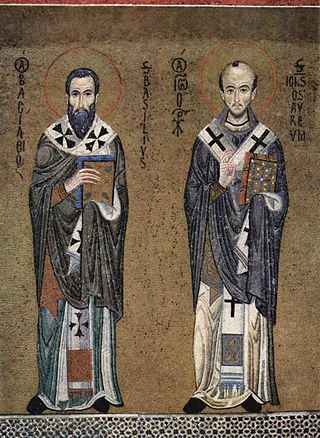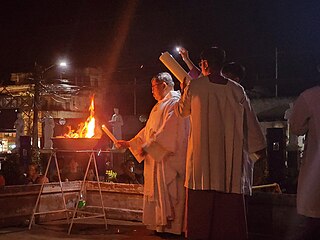Δόξα Σοι τῷ δείξαντι τὸ φῶς.
Δόξα ἐν ὑψίστοις Θεῷ καὶ ἐπὶ γῆς εἰρήνη ἐν ἀνθρώποις εὐδοκία. [note 1]
Ὑμνοῦμέν σε, εὐλογοῦμέν σε, προσκυνοῦμέν σε, δοξολογοῦμέν σε, εὐχαριστοῦμέν σοι, διὰ τὴν μεγάλην σου δόξαν.
Κύριε Βασιλεῦ, ἐπουράνιε Θεέ, Πάτερ παντοκράτορ, Κύριε Υἱὲ μονογενές, Ἰησοῦ Χριστέ, καὶ Ἅγιον Πνεῦμα.
Κύριε ὁ Θεός, ὁ ἀμνὸς τοῦ Θεοῦ, ὁ Υἱός τοῦ Πατρός, ὁ αἴρων τὴν ἁμαρτίαν τοῦ κόσμου, ἐλέησον ἡμᾶς, ὁ αἴρων τὰς ἁμαρτίας τοῦ κόσμου.
Πρόσδεξαι τὴν δέησιν ἡμῶν, ὁ καθήμενος ἐν δεξιᾷ τοῦ Πατρός, καὶ ἐλέησον ἡμᾶς.
Ὅτι σὺ εἶ μόνος Ἅγιος, σὺ εἶ μόνος Κύριος, Ἰησοῦς Χριστός, εἰς δόξαν Θεοῦ Πατρός. Ἀμήν.
Καθ' ἑκάστην ἡμέραν εὐλογήσω σε, καὶ αἰνέσω τὸ ὄνομά σου εἰς τὸν αἰῶνα καὶ εἰς τὸν αἰῶνα τοῦ αἰῶνος.
Καταξίωσον, Κύριε, ἐν τῇ ἡμέρᾳ ταύτῃ, ἀναμαρτήτους φυλαχθῆναι ἡμᾶς.
Εὐλογητὸς εἶ, Κύριε, ὁ Θεὸς τῶν Πατέρων ἡμῶν, καὶ αἰνετὸν καὶ δεδοξασμένον τὸ ὄνομά σου εἰς τοὺς αἰῶνας. Ἀμήν.
Γένοιτο, Κύριε, τὸ ἔλεός σου ἐφ' ἡμᾶς, καθάπερ ἠλπίσαμεν ἐπὶ σέ.
Εὐλογητὸς εἶ, Κύριε. δίδαξόν με τὰ δικαιώματά σου (γ').
Κύριε, καταφυγὴ ἐγενήθης ἡμῖν, ἐν γενεᾷ καὶ γενεᾷ.
Ἐγὼ εἶπα· Κύριε, ἐλέησόν με, ἴασαι τὴν ψυχήν μου, ὅτι ἥμαρτόν σοι.
Κύριε, πρὸς σὲ κατέφυγον, δίδαξόν με τοῦ ποιεῖν τὸ θέλημά σου, ὅτι σὺ εἶ ὁ Θεός μου.
Ὅτι παρὰ σοὶ πηγὴ ζωῆς, ἐν τῷ φωτί σου ὀψόμεθα φῶς.
Παράτεινον τὸ ἔλεός σου τοῖς γινώσκουσί σε.
Ἅγιος ὁ Θεός, Ἅγιος Ἰσχυρός, Ἅγιος Ἀθάνατος, ἐλέησον ἡμᾶς (ἐκ γ').
Δόξα Πατρὶ καὶ Υἱῷ καὶ Ἁγίῳ Πνεύματι,
καὶ νῦν καὶ ἀεὶ καὶ εἰς τοὺς αἰῶνας τῶν αἰώνων. Ἀμήν.
Ἅγιος Ἀθάνατος, ἐλέησον ἡμᾶς.
Ἅγιος ὁ Θεός, Ἅγιος Ἰσχυρός, Ἅγιος Ἀθάνατος, ἐλέησον ἡμᾶς.
(Verses follow that vary according to whether the celebration is on a Sunday or a weekday.) [8] [9] | Glory to you who have shown us the light.
Glory to God in the highest and on earth peace, good will to all people.
We praise you, we bless you, we worship you, we glorify you, we give thanks to you for your great glory.
Lord, King, heavenly God, Father, almighty; Lord, the only-begotten Son, Jesus Christ, and Holy Spirit.
Lord God, Lamb of God, Son of the Father who take away the sin of the world, have mercy on us, you who take away the sins of the world.
Receive our prayer, you who sit at the right hand of the Father, and have mercy on us.
For you only are holy, only you are Lord, Jesus Christ, to the glory of God the Father. Amen.
Each day we bless you, and we praise your name forever and to the ages of ages.
Lord, grant that we may be kept this day without sin.
Blessed are you, Lord, God of our fathers. Your name is praised and glorified throughout all ages. Amen.
Let your mercy, Lord, be upon us, as our trust is in you.
Blessed are you, Lord, teach me your statutes (3).
Lord, you have been our refuge from generation to generation.
I said: Lord, have mercy on me; heal my soul, for I have sinned against you.
Lord, to you have I fled; teach me to do your will, for you are my God.
For you are the source of life, and in your light we shall see light.
Extend your mercy to those who know you.
Holy God, Holy Mighty, Holy Immortal, have mercy on us (3).
Glory to the Father and the Son and the Holy Spirit.
Now and forever and to the ages of ages. Amen.
Holy Immortal, have mercy on us.
Holy God, Holy Mighty, Holy Immortal, have mercy on us. [10] |

















